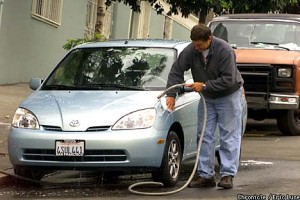In spite of my own recent issues, I had thought Toyota was doing the best it could with its massive recall. James Lentz, president of Toyota USA sales, was all over the press shows last weekend with the two key statements considered essential in the post-Tylenol era: “we screwed up and are sorry” and, “we care about our customers and are very concerned.” (Tylenol took a similar open, earnest tack when someone poisoned some of its bottles in the late 1980s and, coupled with an intensive “get to the bottom of this” campaign [they never did, but they were obviously trying] it saved a brand everyone was writing off. For how NOT to handle a PR disaster see “Woods, Tiger”.)
But today I read this Reuters article that points out Akio Toyoda, the REAL president of Toyota, has said not one single word on the recall problem. And that another Toyota executive blamed the problem on (presumably inferior) U.S. made parts, chosen out of a charitable desire to help struggling American economy! Meanwhile the recall expands to the Prius (different problem, but nobody’s tracking the details any more) and Twitter #Prius traffic, which I’d been following because of my own recent posts, goes from sleepy to through the roof.
Concidentally, my original post about my dead Prius battery has become one of the most-read articles ever on this blog. Lots of new readers are discovering it linked to articles on the Toyota recall as they lick their chops for other Toyota schadenfreude. Speaking of which, my request for some financial relief led to timely response and some nice talks with friendly people in the Toyota Customer Experience Center, but a firm turn-down. I was frankly surprised at that.
[UPDATE for new readers: Toyota has now paid for the replacement battery. Details here.]
My casual research suggested a hybrid battery failure at 70K miles was extremely unusual if not unprecedented. It would seem like a good investment to fix an anomalous problem and placate a good customer who’s been evangelizing your product. Instead, here I am writing another post about problems at Toyota. How is that good for their brand?
